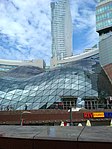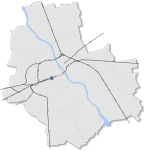Warszawa Centralna railway station
1975 establishments in PolandAC with 0 elementsRailway stations in WarsawRailway stations located undergroundRailway stations opened in 1975 ... and 3 more
Railway stations served by Koleje MazowieckieRailway stations served by Przewozy Regionalne InterRegioŚródmieście, Warsaw

Warszawa Centralna, in English known as Warsaw Central, is the primary railway station in Warsaw, Poland. Completed in 1975, the station is located on the Warsaw Cross-City Line and features four underground island platforms with eight tracks in total. It is served by the long-distance domestic and international trains of PKP Intercity and Polregio as well as some of the regional trains operated by Koleje Mazowieckie. Adjacent to the north side of the building is a bus station that serves as the central hub for night bus lines, and Złote Tarasy shopping center.
Excerpt from the Wikipedia article Warszawa Centralna railway station (License: CC BY-SA 3.0, Authors, Images).Warszawa Centralna railway station
Aleje Jerozolimskie, Warsaw Śródmieście (Warsaw)
Geographical coordinates (GPS) Address Website Nearby Places Show on map
Geographical coordinates (GPS)
| Latitude | Longitude |
|---|---|
| N 52.228611 ° | E 21.003056 ° |
Address
Warszawa Centralna (Dworzec Centralny)
Aleje Jerozolimskie 54
00-024 Warsaw, Śródmieście (Warsaw)
Masovian Voivodeship, Poland
Open on Google Maps










